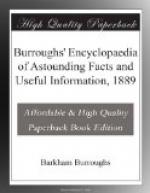How Many Tons of Coal a Large Steamship Consumes in a Day.—“Ocean steamers are large consumers of coal. The Orient line, with their fleet of ships running to Australia every two weeks, may be mentioned. The steamship Austral went from London to Sydney in thirty-five days, and consumed on the voyage 3,641 tons of coal; Her coal bunkers hold 2,750 tons. The steamship Oregon consumes over 330 tons per day on her passage from Liverpool to New York; her bunkers will hold nearly 4,000 tons. The Stirling Castle last year brought home in one cargo 2,200 tons of tea, and consumed 2,800 tons of coal in doing so. Immense stocks of coal are kept at various coaling stations. St. Vincent, Madeira, Port Said, Singapore and others; the reserve at the latter place is about 20,000 tons. It is remarkable with what rapidity these steamers are coaled; for instance, the Orient steamship last year took in over 1,100 tons at Port Said in five hours.”
What a Man Eats.—A French statistician has just ascertained that a human being of either sex who is a moderate eater and who lives to be 70 years old consumes during his life a quantity of food which would fill twenty ordinary railway baggage cars. A “good eater,” however, may require as many as thirty.
An Australian Railway Viaduct.—The Werribee Viaduct, in the colony of Victoria, is the longest work of the kind in Australia. The structure consists of lattice-girder work. It is 1,290 feet in length, and runs to a height of 125 feet above the level of the Werribee river. The viaduct has fifteen spans each of 60 feet, and thirteen spans of 30 feet. The total cost of the bridge was L600,000.
The Sharpening of Tools.—Instead of oil, which thickens and smears the stone, a mixture of glycerine and spirit is recommended. The proportions of the composition vary according to the class of tool to be sharpened. One with a relatively large surface is best sharpened with a clear fluid, three parts of glycerine being mixed with one part of spirit. A graver having a small cutting surface only requires a small pressure on the stone, and in such cases the glycerine should be mixed with only two or three drops of spirit.
Recipes for Plumbers.—Chloride of zinc, so much used in soldering iron, has, besides its corrosive qualities, the drawback of being unwholesome when used for soldering the iron tins employed to can fruit, vegetables and other foods. A soldering mixture has been found which is free from these defects. It is made by mixing one pound of lactic acid with one pound of glycerine and eight pounds of water. A wooden tank may be rendered capable of withstanding the effects of nitric or sulphuric acids by the following methods:—Cover the inside with paraffin; go over the inside with a sadiron heated to the temperature used in ironing clothes. Melt the paraffin under the iron so as to drive it into the wood as much as possible, then with a cooler iron melt on a coat thick




